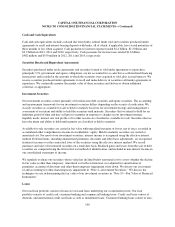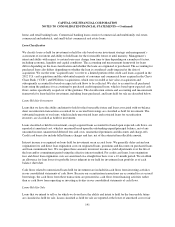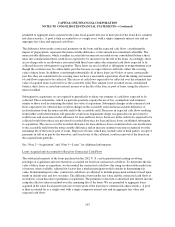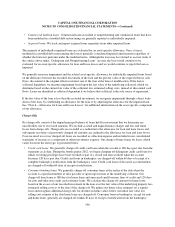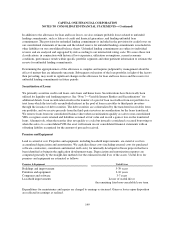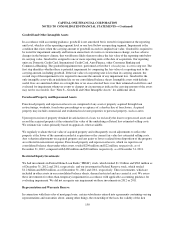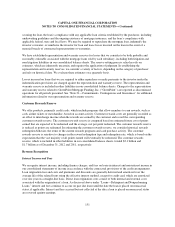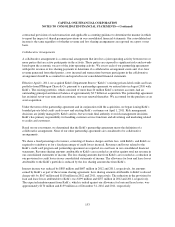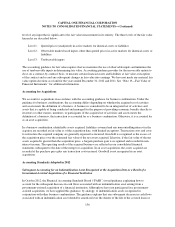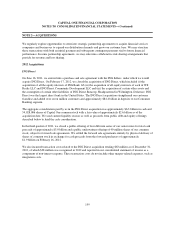Capital One 2012 Annual Report Download - page 169
Download and view the complete annual report
Please find page 169 of the 2012 Capital One annual report below. You can navigate through the pages in the report by either clicking on the pages listed below, or by using the keyword search tool below to find specific information within the annual report.CAPITAL ONE FINANCIAL CORPORATION
NOTES TO CONSOLIDATED FINANCIAL STATEMENTS—(Continued)
Goodwill and Other Intangible Assets
In accordance with accounting guidance, goodwill is not amortized but is tested for impairment at the reporting
unit level, which is at the operating segment level or one level below an operating segment. Impairment is the
condition that exists when the carrying amount of goodwill exceeds its implied fair value. Goodwill is required to
be tested for impairment annually and between annual tests if events or circumstances change, such as adverse
changes in the business climate, that would more likely than not reduce the fair value of the reporting unit below
its carrying value. Goodwill is assigned to one or more reporting units at the date of acquisition. Our reporting
units are Domestic Credit Card, International Credit Card, Auto Finance, other Consumer Banking and
Commercial Banking. The goodwill impairment test, performed at October 1 of each year, is a two-step test. The
first step identifies whether there is potential impairment by comparing the fair value of a reporting unit to the
carrying amount, including goodwill. If the fair value of a reporting unit is less than its carrying amount, the
second step of the impairment test is required to measure the amount of any impairment loss. Goodwill is the
only intangible asset with an indefinite life on our consolidated balance sheets. Intangible assets with definite
useful lives are amortized either on a straight-line or on an accelerated basis over their estimated useful lives and
evaluated for impairment whenever events or changes in circumstances indicate the carrying amount of the assets
may not be recoverable. See “Note 8 – Goodwill and Other Intangible Assets” for additional detail.
Foreclosed Property and Repossessed Assets
Foreclosed property and repossessed assets are comprised of any asset or property acquired through loan
restructurings, workouts, foreclosure proceedings or acceptance of a deed-in-lieu of foreclosure. Acquired
property may include commercial and residential real estate properties or personal property, such as autos.
Upon repossession of property obtained in satisfaction of a loan, we reclassify the loan to repossessed assets and
record the acquired property at the estimated fair value of the underlying collateral less estimated selling costs.
We estimate fair values primarily based on appraisals, when available.
We regularly evaluate the fair value of acquired property and subsequently record adjustments to reflect the
property at the lower of the amount recorded at acquisition or the current fair value less estimated selling costs.
Any valuation adjustments on acquired property and any gains or losses realized from disposition of the property
are reflected in non-interest expense. Foreclosed property and repossessed assets, which we report in our
consolidated balance sheet under other assets, totaled $204 million and $22 million, respectively, as of
December 31, 2012, compared with $169 million and $20 million, respectively, as of December 31, 2011.
Restricted Equity Investments
We had investments in Federal Home Loan Bank (“FHLB”) stock, which totaled $1.3 billion and $362 million as
of December 31, 2012 and 2011, respectively, and our investment in Federal Reserve stock, which totaled
$1.2 billion and $863 million, as of December 31, 2012 and 2011, respectively. These investments, which are
included in other assets in our consolidated balance sheets, deemed restricted and are carried at cost. We assess
these investments for other-than-temporary impairment in accordance with applicable accounting guidance for
evaluating impairment. We did not recognize any impairment on these investments in 2012 or 2011.
Representation and Warranty Reserve
In connection with their sales of mortgage loans, certain subsidiaries entered into agreements containing varying
representations and warranties about, among other things, the ownership of the loan, the validity of the lien
150


